
Galapagos Flights and prices |Galapagos Hotels | diving tips | About us | FAQ | Booking and Payments | News
General Informatio n | Yachts Information | History | Geology | Flora & Fauna | Ecuador
Oceanography | Islands | Diving | Reservations | home | sitemap
e-mail: Contact
Us
USA Toll Free # 1-800-426-0802
Outside US.or Canada 1-305-332-3099- Telefax 954 967 2547
Santa Cruz Island
Our Galapagos cruises in combination with the islands hotels,are the best option to enjoy overnight, cruising the islands you can enjoy whale watching, while diving galapagos along the best dive sites.
BARTHOLOMEW
Location: East of Santiago
island, a small island with the famous Bartholomew pinnacle, 2 dive
sites. Sailing distance is 1-hour and a half from Itabaca Channel (North
side of Santa Cruz island).
Site Conditions: Moderate currents. A platform is found at approximately
10 meters where a variety of reef fishes reside. On the edge of this
platform there are underwater cliffs which start at about 15 meters
deep; good probabilities to observe pelagic species.
Marine fauna: White tip reef shark, reef fishes, barracudas, turtles,
mobulas, stingrays, variety of invertebrates.
COUSINS
Location: Northeast of Santiago
island near Bartholomew island, 1 islet, 2 dive sites located an 1 hour
and a half from Itabaca Channel (North side of Santa Cruz island). Site
Conditions: Normally there are no strong currents at this site; this
is partly a reef dive, partly a wall dive where the endemic black coral
is found.
Marine fauna: sea horses, barracudas, sea lions, Galapagos sharks, white
tip reef shark, turtles, reef fishes, sting rays, eagle rays, variety
of invertebrates. At surface interval penguins can be observed.
NORTH SEYMOUR
Location: North of Santa Cruz
island, 2 dive sites located 30 minutes from Itabaca Channel (North
side of Santa Cruz island).
Site Conditions: For all levels of divers, although sometimes there
can be strong currents, platform reefs with a diversity of species
Marine fauna: sea lions, Hammerheads, Galapagos sharks, white tip reef
shark, hammerhead shark, mobulas, turtles, reef fishes, sting rays,
eagle rays, Galapagos eel, barracudas, variety of invertebrates.
BEAGLE
Location: South of Santiago
island, 3 exposed rocks, 2 dives sites located an 1 hour and a half
from Itabaca Channel (North side of Santa Cruz island).
Site Conditions: Normally there are no strong currents at this site,
reef dive with many corals and sponges.
Marine fauna: sea lions, Galapagos sharks, turtles, reef fishes, stingrays,
eagle rays, barracudas, variety of invertebrates, manta rays and probably
solitary hammerhead sharks.
DAPHNE
Location: North of Santa Cruz
island, an exposed rock, one dive site located 30 minutes from Itabaca
Channel (North side of Santa Cruz island).
Site Conditions: Normally there are no strong currents at this site,
rocky and sandy bottom.
Marine fauna: here we find a small cave (this is NOT a cave dive) where
white tip reef sharks rest, additionally there is a pinnacle where we
find a diversity of rays, Galapagos shark, turtle, ref. fishes, barracudas,
black coral walls and variety of invertebrates.
MOSQUERA
Location: North of Santa Cruz Island between Seymour Island and Baltra
island, this is an islet that emerges from the sea (sand bar), one dive
site located 25 minutes from Itabaca Channel (North side of Santa Cruz
island).
Site Conditions: Normally there are no strong currents at this site,
sandy bottom between 15 and 18 meters with garden eels and pelagic species,
there is also a wall that starts at 18 meters where we also find black
coral and variety of invertebrates. Activity: Hammer head sharks, black
tip reef shark, white tip reef shark, sea lions, turtles, barracudas,
ref. fishes, sting rays, eagle rays, mobulas, Galapagos eel, variety
of invertebrates
FLOREANA

Flamingos lagoon-Floreana
Punta Cormoran in Floreana offers a great possibility for the visitor to enjoy some beach time in the Galapagos. Here, the extroverted mockingbirds sit on top of visitor’s hats, peck at their feet and investigate their belongings,also sea lions colonies.
The island of Floreana is about 2 hours south from our dive base. There are 9 dive sites here with generally calm waters. On the occasion that we do find strong currents, we can quickly move to another site, which makes Floreana ideal for all levels of divers.
POST OFFICE Is the best known for its colorful history of pirates, whalers, convicts and.by British whalers to send letters to and from England. This tradition has continued over the years, and even today. This tradition has continued over the years and even today visitors may drop off and pick up letters, without stamps, to be carried to far off destinations. Punta Cormorant offers two highly contrasting beaches. The landing beach is of volcanic origin and is composed of olivine crystal, giving it a greenish tinge. At the end of the short trail is a carbonate beach of extremely fine white sand. Formed by the erosion of coral skeletons; it is a nesting site for green sea turtles. Between these two beaches is a salt lagoon frequented by flamingos, pintails, stills, and other wading birds. An old eroded volcanic cone called Devil's Crown is a popular roosting site for seabirds such as boobies, pelicans, and frigates. Red-billed tropicbirds nest in rocky crevices.

The center of the crown is an outstanding snorkeling spot full of sea lions and colorful fish. You may look on as barber fish clean sea urtles of parasites. Floreana is also one of the best sites to dive with sea lions. If that isn't enough there is the enticing gauntlet of sea horses, stingrays, eagle rays, turtles, long nose hawk fish, barracudas, pelagic fish, white tip reef sharks, Galapagos sharks, and hammerhead sharks
Sierra Negra volcanoe-Isabela Island
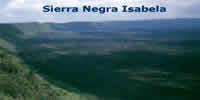
Created by the lava of six volcanoes that flowed together, this 1800 squared foot island is the largest in Galapagos. Graffiti dating back to the 1800's is written on the rocky cliff left over from bucanneers and whaling ships. The trails lead to a salt water lagoon and offers a great view of the lava fields and the ocean. A Panga ride reveals penguins, shearwaters and noody terns.
Isabela island
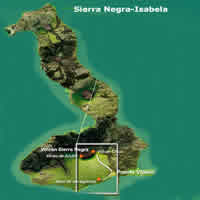
Santa Cruz island
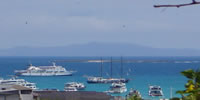
Supports one of the largest
human populations of the four inhabited islands. Some 25,000 residents
are distributed between the cattle farming communities in the lush highlands
and the coastal town of Puerto Ayora. Here you can visit the Charles
Darwin Research Station to see the huge land tortoises, which once flourished
in the islands. The populations were decimated in the early 1800's by
the whaling ships that stopped in the
islands to fill their holds with fresh meat. A bus ride into the highlands
takes you to Los Gemelos, two deep pit craters situated in the scalesia
forest with lots of interesting bird life, or for a trek through the
gigantic lava tubes, or to the Tortoise Reserve to search for large
tortoises in their natural habitat. On the north shore of the island,
accessible only by the sea, is an extensive mangrove lagoon called Black
Turtle Beach. Here in the peacefulness of the mangroves turtles break
the surface of the still waters, while fish, rays and small sharks cruise
below.
We offer a detailed briefing prior to each dive and a checkout dive to all new passengers in a calm environment. Guides are locals, trained in our dive center and have a minimum of 3 years experience. We provide a guide for groups of 4-8 passengers depending on their training level. For introductory dives the maximum depth is 12meters/40feet and it is required that a guide accompany one introductory diver at a time. ● The depths and bottom time are planned and established according to PADI’s norms and depend on the divers’ level of experience. The maximum depth of the dives varies between 15mt (50 feet) and 30mt (100 feet), the maximum bottom time is of one hour and the minimum surface interval is one hour. ● Each diver will have to present his/her dive certification (PADI, NAUI, SSI, ACUC, DIVA, CMAS, FEDAS, YMCA, ETC...) and logbook. Also, the divers will have to sign the release of responsibility and expressed assumption of risk. For minors; their parents or legal guardians will have to sign (minimum age to dive is 12 years old). ● To practice recreational dive activities the diver must be in good health and not under the influence of alcohol or drugs. Passengers who declare health problems will need a doctor’s authorization permitting them to dive. ● Our daily dive tours included 2 dives (except introductory and night dive), two dives, dive boat, dive guides, diving tanks and weight belt), lunch. Our dive boat complies with the Ecuadorian Marine security prerequisites and norms. Additionally, our first aid kit includes 2 oxygen tanks (one hour’s duration). We are affiliated to the hyperbaric chamber;
Puerto Ayora on Santa Cruz Island is full of gift and souvenir stores, as well as all sorts of Ecuadorian craftwork. Although the prices are much higher than stores on mainland Ecuador, they are cheaper than the cruise ships’ boutiques.Puerto Ayora is the place to be for nightlife in the Galapagos. In the center of the archipelago, Santa Cruz Island has a fair number of pubs and discotheques that stay open until late into the night.
Single supplement:There is no single charge for the diving boat,but there is for hotels and transfers.
Galapagos cruises with our hotel based diving is great year around, check our new scuba diving tours, from Santa Cruz,and Isabela islands, includes diving, hiking, horseriding,snorkeling.

M/Y Pacifica
These Packages includes;
Quito-Ecuador, arrival transfers to first class Hotel , overnight, transfers to Airport, flight Quito- Glpgs. R/T, Santa Cruz island and transfers; Santa Cruz Tourist class Hotel , 7days/6 nights diving tour; breakfast, lunch , 2 dives per day;returning transfer to first class Hotel in Quito, overnight, transfer to Airport back to home city .

TOTAL 09 DAYS / 08 NIGHTS $ 2.980 , based with first class Hotel in Quito,Tourist Hotel in SANTA cRUZ and ISABELA islands
Day 01: (any day) Quito
International Arrival in Quito-Ecuador, transfer and check in at hotel. Upon early arrival, add city tours can be arranged.
Day 02 (any day) Quito-Baltra Airport-Santa Cruz-Galapagos

Hotel Mainao-Santa Cruz
Transfer to airport for flight to Baltra Airport-Santa Cruz island, Arrival , Transfer and check in at a confortable hotel. After lunch,we begin with our first visit to the interpretation center at the Charles Darwin Staion. After we can check our dive equipment for the next day dive, getting familiar with your personal diving equipment.
Hotel overnight and relax
Day 03:(any day) Santa Cruz Island
Below you find our regular Itinerary to follow depending on the day of the week you chose.
2012- ITINERARY
MONDAY: Floreana OR Gordon
TUESDAY: Gordon OR Beagle / Daphne
WEDNESDAY: Seymour (the channel) / Mosquera (North)
THURSDAY: Cousins / Bartolome
FRIDAY: Mosquera (South) / Seymour (the point)
SATURDAY: Beagle / Daphne OR Daphne / Gordon, 2 dives SUNDAY: Seymour
(the canal) / Gordon OR Floreana, 2 dives
Depending on the day you started, the following
activities:
After Breadfast we begin our day taking our fast boat to any of the
dive sites mentioned above, There is a first dive early in the morning
in one of the best dive sites of the Archipelago, You can have an immersion
in clear water and watch a rich marine fauna, many kinds of sharks,
sea turtles, white tip sharks, hundreds of diferent species of fish,
after having a good lunch, we return to Port. return to Port. Hotel
overnight and relax
Day 04 (any day) Santa Cruz island.
After breakfast, early departure to the island of Floreana, where we’ll have one immersion in Champion Isle, one of best dive sites in Floreana, with calm waters most of the time.after Lunch, we'll visit the giant tortoises and Asilo de la Paz, an historic site from the early colonists on this island, here we find the smallest population among the 4 inhabitated islands of the archipelago.
Wittmers Hotel, overnight .
Day 05 (any day) Santa Cruz
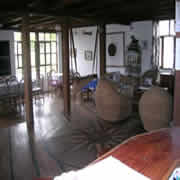
Hotel Ballena Azul
After a early Breakfast we continue sailing to Isabela island, where we will have a dive in Tortuga isle, a small islet where we can spot hammerheads sharks, manta rays, lots of invertebrates, sea lions, then we arrive in Puerto Villamil for lunch. Visit to the National Park breading of giant tortoises corrals, where we can learn more about these unique species.Close from here, we can find the flamingos swamps. Then We take a Swim in Villamil beach.
Hotel overnight for relaxation
Day 06: (any day) Isabela Island
After breakfast, in a short bus ride, our first stop is Santo Tomas village, from where we will continue by horseback riding, to one of the most active volcanoes on earth, the Sierra Negra caldera, for about hour and a half ride to the top of the rim, a 10 kms wide, the second largest of the world, from where we can have a short walk to one of the main volcano vents, noting the fresh lava activities, from this point you can have an impresive moon-like view of the islands, almost a 1.000 mts. in high.After a fine lunch, we wil begin descending by horse to Santo Tomas, for the return to Port.
Sailng to Santa Cruz island
Hotel overnight and relax
Day 07: (any day) Isabela island
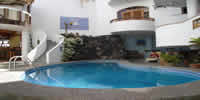
Hotel Lobo de Mar
After breakfast,By bus we will head up to the Santa Cruz highlands, to visit to some of the ramainings of the volcanic movements,through thousand of years, the lava tunnels, where you can verify the diferent lava layers when the island has been formed .Return to Port.
By our fast boat we sail to Santa Fe ,for a shallow dive, through our way back to Cristobal. Hotel overnight.
Day 08 (any day) baltra Airport-Quito
After an early Breakfast we have a chance to visit local handcraft stores, then we take a transfer to airport for flight back to Quito .Transfer to Quito Hotel- overnight
Day 09 (any day) Airport-Quito
Breakfast and transfer to Quito Airport for international flights.
Single surcharges are $ 350.00 for a single traveler who do not wish to share a double occupancy
INCLUDED/EXCLUDED
Included in tour cost - Domestic Flight Quito/Galapagos/Quito. Airfare: $385 Low Season / $520 High Season, subject to change - Bilingual english speaking naturalist guide - All land and sea transportation during the itinerary - All hotel accommodations in first class and tourist superior hotels *including continental breakfasts (on a twin share basis) - All meals as noted - snorkeling gear - sea transportation
Excluded in tour cost - International round-trip airfare travel to and from Ecuador - Entrance fee to Galapagos National Park (100 USD) - Hiking boots and other necessary sports gear - Lunches and dinners in the cities (unless otherwise specified) - Personal expenses (tips and gratuities, alcoholic beverages, medical or travel insurance, laundry, airport taxes, etc.)
Marine Currents
The Galapagos Islands waters have the Humboldt Current's influence that
brings cold waters especially during the mist rainy season (from July
to December). During the warm season (January to June), the southeast
trade winds become weaker and the water from the Panama Basin remains
warm. During this season climate is tropical with some occasional rains.
"El Nin~o" current may cause a much greater flow of warm waters,
making the surface warmer and rainfall increase.
Average Water Temperature
January-June: 70°F-80°F (20C-26C)
July - December: 65°F - 75°F (18C- 23C)
Visibility:
Average visibility is from 8 to 10 meters (25ft to 35ft); on good visibility
days it can reach approximately 18 meters (60ft).
Sea Conditions:
From July to December the sea is choppy, strong surge, strong winds.
Sailing time is longer (by 30 - 40 minutes approximately) when comparing
to calm season sailing time. Anti-seasickness medication is recommended.
From December to June the sea is calm with gentle breeze; sailing is
easier.
Galapagos diving cruises.-services ● The packages include: accommodation, breakfast and lunch , scuba tanks and weights, dive boat, dive guides, and 1 daily dive. ● Itineraries can change depending on meteorological conditions, level and experience of divers.●
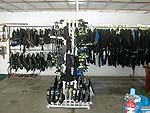
● To practice recreational dive activities the diver must be in good health and not under the influence of alcohol or drugs. Passengers who declare health problems will need a doctor’s authorization permitting them to dive. ● Our daily dive tours included 2 dives (except introductory y night dive), two dives, dive boat, divemaster guides, diving gear (complete wetsuit, regulator with octopus, BCD, mask, snorkel, fins, booties, gloves, scuba tuba, tanks and weight belt), lunch . Our dive boat complies with the Ecuadorian Marine security prerequisites and norms. Additionally, our first aid kit includes 2 oxygen tanks (one hour’s duration). We are affiliated to the hyperbaric chamber; our passengers are covered 80% specifically for dive accidents.
